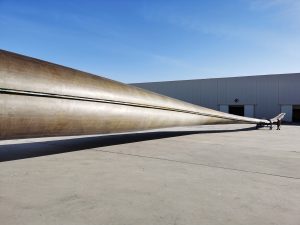
Length definitely matters in a new PU-based wind turbine blade
Canadian Plastics
Materials Research & DevelopmentDeveloped by Covestro, Goldwind, and LZ Blades, the project could mark the beginning of a new generation of longer and stronger blades for the wind power industry.

Photo Credit: Covestro
In what’s being described as the beginning of a new generation of longer and stronger blades for the wind power industry, material supplier Covestro has successfully developed a 64.2-meter wind turbine blade made completely of polyurethane. The blade, made jointly with Chinese wind turbine manufacturer Goldwind and wind blade manufacturer LZ Blades, represents a breakthrough in the application of polyurethane resin in large-scale wind turbine blades, Covestro said.
The full polyurethane wind turbine blade, from the spar cap to the shear web and the shell, is made entirely of polyurethane infusion resin, making it the first of its kind in the global wind power industry. Extensive static and dynamic fatigue tests are being carried out to evaluate the durability of the wind turbine blade before small-scale production commences in 2020.
“In the course of our R&D cooperation with Goldwind and LZ Blades, the superior properties of polyurethane resin were further proven through this trial production. We believe that Covestro’s solution can greatly contribute to the sustainable development of the wind power industry,” said Dr. Irene Li, head of application development, Asia Pacific in the polyurethanes segment at Covestro.
Test results showed that the polyurethane resin displays better mechanical properties compared with traditional epoxy resin. As it does not require post-curing and has a lower viscosity and faster infusion speed, the polyurethane resin system can greatly improve the efficiency of blade production, thus increasing the competitiveness of blade manufacturers. In the end, the solution with the polyurethane resin is more cost competitive than the one with the epoxy resin.
In addition, Goldwind has optimized the structural design of the blade, giving better play to the advantages of polyurethane’s mechanical properties and infusion speed and ensuring the smooth production of the blade.
“Polyurethane is a very cost-effective material, and can thus provide great support for wind power enterprises when wind power prices will reach parity with thermal power after 2020,” said Birong Wen, head of Goldwind’s wind blade development team. “In the future, we will invest more in the development of new materials and explore how to apply these technologies to large-scale offshore blades to achieve greater competitiveness. This will help boost the upgrading of materials for wind turbine blades and the continuous innovation of the industry.”
